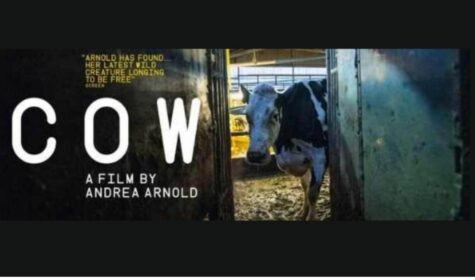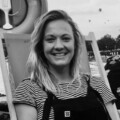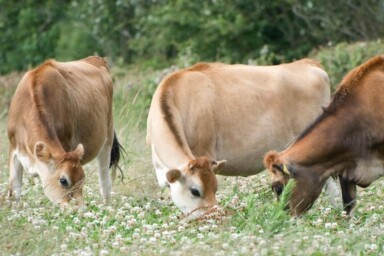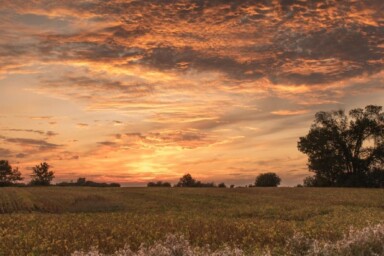Director: Andrea Arnold
The recently released documentary ‘Cow’, is a confronting and bleak insight into the realities of life as a cow on a large-scale industrial dairy farm somewhere in the south of England. Shot over the course of four years, the film chronicles the daily life of one intensive dairy cow, Luma (a veteran mother of 6 calves), who eats and is milked in what seems like a never-ending cycle, until that is, she meets her fatal end.
Before I share my opinion of the film, it’s worth saying that although I’m not a dairy farmer, I do have an interest in UK dairy production, and I consume dairy products. Given this, I was pleased to see that a documentary depicting life as a dairy cow had made it on to the big screen. As noted in a Guardian review of the film, ‘Cows and pigs in the UK don’t usually get the kind of David Attenborough treatment reserved for lions and tigers.’
The film begins with the birth of Luma’s latest calf, who is swiftly taken away from her and put into a separate rearing pen. Several chilling moments follow, during which it seems as though Luma is suffering from grief. She stares into the lens of the camera for several minutes, mooing continually, and later-on appears to be refusing to eat.
The removal of calves from their mothers is common practice in the dairy industry, and it often takes place within days or even hours of birth. Calves are then generally fed from a bucket or nipple feeder with a milk replacer (usually a powdered by-product of dairy processing). This allows farmers to continue milking the mothers and selling the milk that the calves would otherwise drink.
Public concern around animal welfare has led to the growth of alternative methods of production, whereby the calves are not removed immediately from their mothers (a practice sometimes known as ‘ethical dairy farming’ or ‘calf at foot’). Practitioners of ethical dairy farming say that it helps to reduce calf mortality and protects cows from mastitis. However, it also adds up to a huge amount of milk that the farmer cannot sell. Hence, milk produced in this way is often sold at a higher price.
Others, however, feel strongly that the longer you leave the calf with the cow, the bigger the stress caused when they are eventually separated. At their farm in West Wales, Patrick and Becky Holden choose to keep all the calves with their mothers for at least two or three days, and often longer. In the case of female calves (heifers), they will either suckle their mother for 12 weeks, or they are fostered by another cow, with strong maternal instincts. The most important thing, Patrick says, is that cows are shown compassion and respect, as ‘this also affects the quality of the milk’.
As the film progresses, there are brief, uplifting moments, with calves playing together and kind workers calling the cows by name. However, another aspect of the film that many will have found shocking, is just how little time the cows on this farm spend outside. It is at least 45 minutes in, before we see a field of grass. In the UK, dairy cows are traditionally kept in fields during the spring and summer months and housed indoors during the winter. However, dairy farmers are under pressure to intensify their methods of production, producing their milk as quickly as possible, by feeding their cows cereals and imported soya (with enormous environmental implications), and often keeping them indoors for most of the year. ‘Zero-grazing’ is an increasingly common practice, linked to mega-dairies in the UK (often containing thousands of cows on a single farm). In contrast, organic standards require cows to spend as much time outdoors as possible, with grass making up a minimum of 60% of their diet. At Holden Farm Dairy, the herd is small, comprising 75 cows that can walk to grass twice a day during the grazing season and feed on lush, herb rich pastures. During the winter, they are mainly fed silage or hay, topped up with home-grown organic crops such as oats and peas.
I am sure that many viewers of the film ‘Cow’ will come away feeling depressed, and some may even decide to give up dairy altogether. In an interview following the release of the film, Arnold said, ‘I’ve had plenty of people say to me afterwards they had no clue that’s how milk came about. Farmers told me that they’ve had kids do tours who think that milk comes out if you lift their tail.’ A lack of understanding as to where our food comes from, has led to public confusion around what to eat to be healthy, sustainable and supportive of animal welfare.
Films like ‘Cow’ present one side of the story, and it’s an important one to share. However, there are alternative methods of dairy production across the UK which also deserve attention – systems where cows are allowed out to graze for most of the year and where more is done to make the cows as contented as possible. When presented with the facts, it is then up to citizens to decide on what they wish to consume, whether conventionally produced dairy, organic, or indeed plant-based alternatives.





